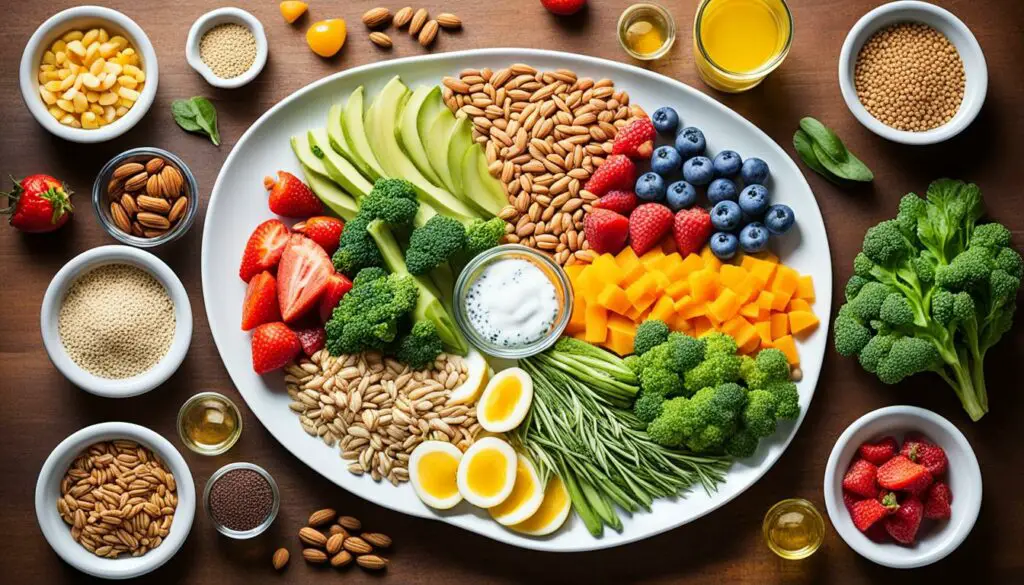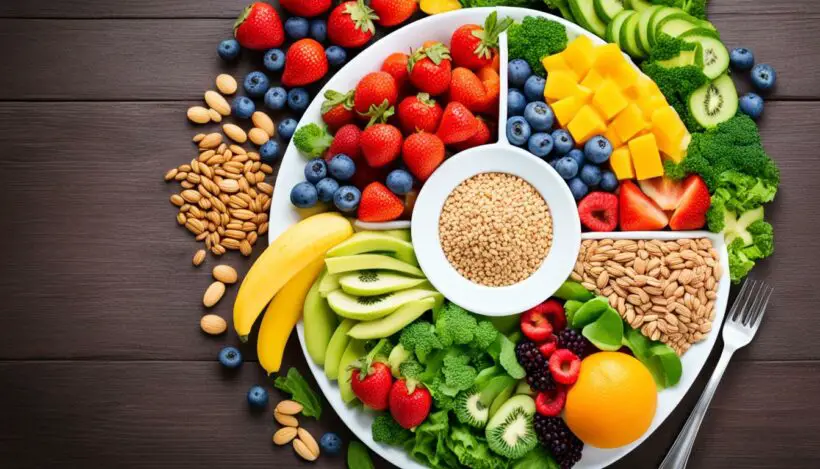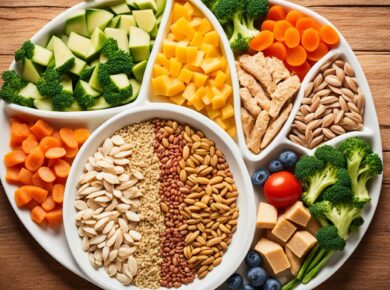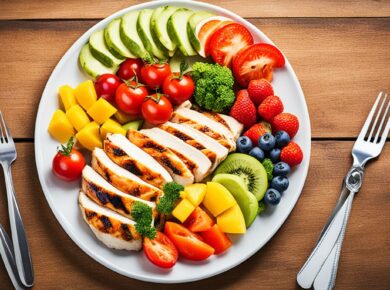A healthy diet plan is essential for overall well-being and maintaining a balanced lifestyle. It is not a one-size-fits-all approach but needs to be personalized to meet individual needs and goals. Incorporating a nutritious meal plan and a balanced eating regimen can help you achieve vibrant health and vitality.
Before embarking on any new diet plan, it is crucial to consult with a healthcare provider or a registered dietitian. They can provide personalized guidance based on your specific requirements, taking into account factors such as your current health condition, lifestyle, and dietary preferences.
A healthy, balanced diet typically includes a variety of whole grains, fruits, vegetables, lean proteins, and healthy fats. These food groups provide essential nutrients, vitamins, and minerals necessary for optimal health. Additionally, meal planning can be a helpful tool to stay on track, meet your nutrition goals, and even save money. [1]
The Importance of Meal Planning
Meal planning is a game-changer when it comes to achieving your nutrition goals. It doesn’t have to be complicated or time-consuming. With just a little bit of effort, you can reap numerous benefits including reducing food waste and saving money.
One of the key advantages of meal planning is that it helps you stay on track with your nutrition goals. By taking the time to plan your meals in advance, you can ensure that you’re making intentional choices about the food you consume. Whether you’re aiming to lose weight, build muscle, or simply eat a balanced diet, meal planning provides a structure that supports your objectives.
Another major benefit of meal planning is that it can help reduce food waste. When you plan your meals ahead of time, you can make sure that you’re utilizing ingredients efficiently and minimizing the risk of spoilage. By using up all the ingredients you purchase, you not only save money but also contribute to reducing food waste, which is a critical sustainability concern.
Speaking of saving money, meal planning is a budget-friendly approach to eating well. By planning your meals in advance, you can create a shopping list that includes only the ingredients you need. This means you’re less likely to make impulse purchases or buy items that end up sitting in the back of your pantry. By being more strategic with your grocery shopping, you can save money and stick to your budget.
Simple Steps to Get Started with Meal Planning
Don’t know where to start with meal planning? Here are some simple steps to help you get organized:
- Create basic meal constructs: Start by dividing your meals into categories like breakfast, lunch, dinner, and snacks. From there, brainstorm simple meal ideas that align with your nutrition goals.
- Make a shopping list: Once you have your meal ideas, make a shopping list of the ingredients you’ll need. Be sure to check your pantry and fridge to avoid purchasing items you already have.
- Shop strategically: When you go grocery shopping, stick to your list and avoid unnecessary purchases. Consider buying in bulk for staple items to save money in the long run.
- Prepare food ahead of time: Take some time to prepare food in advance, such as chopping vegetables or cooking large batches of grains or proteins. This will make mealtime easier and more convenient throughout the week.
By following these simple steps, you’ll be well on your way to meal planning success. Remember, it’s all about finding a method that works for you and making it a habit. Before you know it, you’ll be enjoying the benefits of meal planning, from staying on track with your nutrition goals to reducing food waste and saving money.
Considerations for a Healthy and Balanced Diet
When planning a healthy and balanced diet, it’s important to consider various factors such as nutrition needs, taste preferences, cooking ability, medical conditions, and budget.
Everyone’s nutritional needs vary based on factors like gender, height, weight, and activity level. It’s essential to tailor your diet plan to meet your specific needs and goals.
Consider incorporating a variety of vegetables, fruits, whole grains, lean proteins, and healthy fats into your meals. This ensures that you are getting a wide range of nutrients and flavors to support your overall health.
If you have specific dietary requirements due to medical conditions, such as diabetes or food allergies, it’s important to consult with a healthcare professional or registered dietitian for personalized guidance.
Moreover, take into consideration your taste preferences and cooking ability. If you enjoy certain flavors or have limited cooking skills, find recipes and ingredients that align with your preferences and abilities.
Lastly, don’t overlook your budget. Healthy eating doesn’t have to be expensive. Plan your meals and make a shopping list to ensure you stay within your budget while still meeting your nutritional needs.
Sample Daily Menu for a Healthy and Balanced Diet
Planning a daily menu for a healthy and balanced diet is essential to fuel your body with the nutrients it needs. A well-rounded menu should include a combination of macronutrients – protein, fiber, complex carbohydrates, and a little bit of fat. By focusing on nutrient-dense foods, you can support your overall health and well-being. Below is a sample daily menu that can serve as a starting point for your own personalized meal plan.
Breakfast:
- Grapefruit and poached eggs
Start your day with a burst of citrusy flavor from a refreshing grapefruit. Pair it with protein-rich poached eggs for a satisfying and nutritious breakfast. The grapefruit provides vitamin C and fiber, while eggs offer high-quality protein to keep you feeling full and energized throughout the morning.
Lunch:
- Grilled chicken breast with a large garden salad
Maintain your momentum with a lunch that combines lean protein, fresh vegetables, and vibrant flavors. Enjoy a grilled chicken breast for a good source of protein, and accompany it with a generous portion of mixed greens, colorful vegetables, and your favorite salad dressing. This meal provides essential nutrients, fiber, and hydration.
Dinner:
- Halibut with steamed broccoli and brown rice
End your day with a delicious and nutritious dinner featuring halibut, steamed broccoli, and brown rice. Halibut is a lean source of protein and heart-healthy omega-3 fatty acids. Steam the broccoli to retain its nutrients, and serve it alongside fiber-rich brown rice for a well-balanced and satisfying meal.
Remember, your daily calorie intake may vary based on factors such as individual hunger levels and energy needs. A general guideline is to aim for approximately 100 to 250 calories for snacks and 300 to 600 calories per meal. Adapt this sample daily menu to suit your calorie goals and personal preferences, keeping in mind the importance of including a variety of nutrient-rich foods in your overall diet.
Beverages and Hydration
Hydration is an essential component of maintaining a healthy diet plan. Your fluid needs can vary based on factors such as age, sex, activity level, and medical history. To stay adequately hydrated, experts generally recommend drinking around 9 cups of water per day for women and 13 cups for men.
When planning your beverage choices, it’s important to consider more than just your hydration needs. Many beverages can be high in calories and contribute to excessive sugar intake. Sugar-sweetened beverages, such as sodas and certain fruit juices, can be particularly problematic for overall health and weight management.
To promote a healthy diet plan, it’s advisable to reduce or eliminate the consumption of sugar-sweetened beverages whenever possible. Instead, choose water as your primary beverage. Water is calorie-free, hydrating, and essential for overall well-being. It’s also a great way to quench your thirst without adding unnecessary calories or sugar to your diet.
Remember, you can jazz up your water by adding a slice of lemon, cucumber, or a few sprigs of mint for added flavor and freshness. Staying well-hydrated throughout the day can help support your energy levels, digestion, and overall health.
Benefits of Staying Hydrated:
- Supports proper digestion and nutrient absorption
- Helps maintain healthy-looking skin
- Regulates body temperature
- Aids in the transportation of nutrients and oxygen
- Helps flush out toxins from the body
Nutritional Recommendations from Dietary Guidelines
The 2015-2020 Dietary Guidelines for Americans provide valuable recommendations for maintaining a healthy eating pattern. These guidelines emphasize the importance of consuming a variety of foods from all food groups, including vegetables, fruits, grains, dairy, and proteins.
By incorporating foods from these different groups, you can ensure that your body receives the necessary nutrients for optimal health. Vegetables and fruits provide essential vitamins, minerals, and fiber, while grains offer energy and a range of nutrients.
Dairy is an excellent source of calcium and vitamin D, which are important for bone health. Proteins, whether from animal or plant sources, provide essential amino acids that support growth and repair.
It’s also crucial to consider the negative impact of certain constituents on our health. The guidelines recommend limiting the intake of saturated fats, added sugars, and sodium. Saturated fats, found in foods like red meat and full-fat dairy products, can contribute to heart disease.
Added sugars, often found in processed foods and sugary beverages, can lead to weight gain and increased risk of chronic diseases. Sodium, predominantly consumed through processed foods and restaurant meals, can raise blood pressure and increase the risk of heart disease.
To promote a healthier diet, it’s important to make smart choices when it comes to fats, sugars, and sodium. Opt for healthier sources of fats, such as avocados, nuts, and olive oil. Choose naturally occurring sugars from fruits rather than added sugars. Reduce the consumption of processed meats, high-sodium snacks, and packaged meals.
By following the dietary recommendations outlined in the 2015-2020 Dietary Guidelines, you can establish a healthy eating pattern that supports overall well-being and reduces the risk of chronic diseases.
The Healthy Eating Plate Guide
The Healthy Eating Plate is a comprehensive and practical guide to help you create balanced and nutritious meals. This guide emphasizes the importance of incorporating a variety of food groups and making mindful choices to support your overall health and well-being.
To follow the Healthy Eating Plate guide, consider the following tips:
- Balance your meals: Aim to include a variety of vegetables, fruits, whole grains, and protein sources in each meal. This ensures you get a wide range of essential nutrients to support your body’s functions.
- Choose healthy oils: When cooking or preparing meals, opt for healthy oils like olive oil, avocado oil, or coconut oil. These oils provide essential fatty acids and can contribute to heart health.
- Incorporate plenty of vegetables and fruits: Fill half of your plate with colorful vegetables and fruits. These are rich in vitamins, minerals, fiber, and antioxidants to support your overall health.
- Opt for healthy protein sources: Include lean proteins such as fish, chicken, tofu, beans, or legumes in your meals. These provide important amino acids for muscle repair and growth.
- Choose whole grains: Replace refined grains with whole grains like quinoa, brown rice, or whole wheat bread. Whole grains are rich in fiber, which helps promote digestion and keep you feeling fuller for longer.
- Stay hydrated with water: Make water your primary beverage throughout the day. Water supports essential bodily functions, aids digestion, and helps maintain overall hydration levels.
Remember to listen to your body, respect your hunger and fullness cues, and practice portion control. The Healthy Eating Plate guide is a simple yet effective tool to help you make informed and balanced food choices.
Building a Healthy and Balanced Diet
To build a healthy and balanced diet, it’s important to prioritize the right foods and make smart choices. Here are some key components to consider:
1. Include Plenty of Vegetables and Fruits
Vegetables and fruits are packed with essential nutrients, vitamins, and minerals. Aim to include a variety of colorful options in your meals and snacks. Whether it’s leafy greens, crunchy carrots, or juicy berries, these natural wonders provide antioxidants and fiber to support overall health. They can be enjoyed raw, steamed, roasted, or sautéed, ensuring that you get the most out of your produce.
2. Aim for a Variety of Whole Grains
Whole grains provide a good source of dietary fiber, vitamins, and minerals. Opt for whole wheat bread, brown rice, quinoa, oats, and other whole grain products. These foods can help with digestion, manage weight, and maintain energy levels. Be mindful of portion sizes and choose whole grains over refined grains whenever possible.
3. Include Lean Proteins
Protein is an essential macronutrient that supports muscle growth and repair. Choose lean sources of protein such as skinless poultry, fish, tofu, beans, and legumes. These options are low in saturated fats and high in beneficial nutrients, making them a healthy addition to your diet. Incorporate them into your meals to provide necessary amino acids for your body to function optimally.
4. Moderate Intake of Healthy Oils
Healthy oils, such as olive oil, avocados, and nuts, provide good fats that are important for overall health. They are a source of monounsaturated and polyunsaturated fats, which can help reduce the risk of heart disease and promote brain function. Use these oils in moderation when cooking or as dressing for your salads.
5. Stay Hydrated with Water
Water is essential for good health and plays a vital role in various body functions. Aim to drink enough water throughout the day to stay properly hydrated. It helps flush out toxins, aids digestion, and keeps your skin glowing. Make it a habit to carry a reusable water bottle with you to remind yourself to drink water regularly.
6. Incorporate Physical Activity into Your Daily Routine
Physical activity is an integral part of a healthy lifestyle. Find activities that you enjoy and make them a regular part of your day. Whether it’s walking, cycling, dancing, or practicing yoga, staying active helps maintain a healthy weight, improves cardiovascular health, and boosts mood. Aim for at least 30 minutes of moderate-intensity exercise most days of the week.
The key to building a healthy and balanced diet is to make small, sustainable changes over time. By incorporating more vegetables and fruits, choosing whole grains, including lean proteins, moderating healthy oils, staying hydrated with water, and being physically active, you can create a diet that supports your overall well-being.

Conclusion
Crafting a healthy diet plan is a personal journey that prioritizes individual needs and goals. By following a balanced eating regimen and making intentional choices, you can achieve vibrant health and well-being. Incorporating nutritious foods into your daily meals is essential for providing your body with the nourishment it needs to thrive.
Consulting with a healthcare provider or registered dietitian is crucial for personalized nutrition guidance. They can help tailor your diet plan based on your specific requirements, taking into account factors such as dietary restrictions, medical conditions, and personal preferences. Their expertise will ensure that you receive the most effective and sustainable approach to your healthy diet plan.
Embark on your journey towards a healthy diet plan today and experience the benefits of improved overall health and vitality. By making conscious choices and embracing a balanced eating regimen, you can take control of your well-being and enjoy a life filled with vibrant health.






